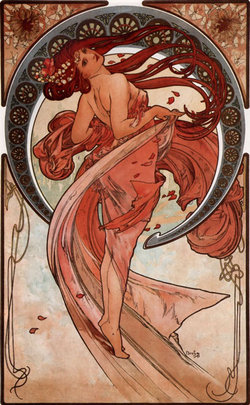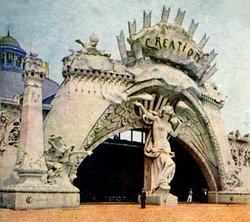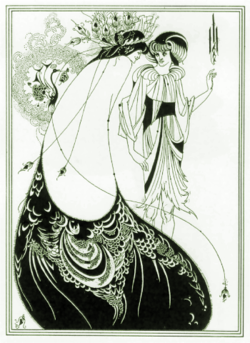Art Nouveau
|
|
Art Nouveau ("new art" in French) is an art and design style that peaked in popularity at the beginning of the 20th century. Other, more localized terms for the cluster of self-consciously radical, somewhat mannered reformist chic that formed a prelude to 20th-century modernism, included "Jugendstil" in Germany, named for the snappy avant-garde periodical Jugend ('Youth') or "Sezessionstil" in Vienna, where forward-looking artists and designers seceded from the mainstream salon exhibitions, to exhibit on their own in more congenial surroundings.
In Russia, the movement revolved around the art magazine World of Art, which spawned the revolutionary Ballets Russes. In Italy, "Stile Liberty" was named for the London shop, Liberty & Co, which distributed modern design emanating from the Arts and Crafts movement, a sign both of the Art Nouveau's commercial aspect and the "imported" character that it always retained in Italy. In Catalonia, the movement was centred in Barcelona and was known as "modernisme", with Antoni Gaudí as the most noteworthy practioner.
| Contents [hide] |
Career of Art Nouveau
Art Nouveau started in the 1880s and climaxed in years 1892 to 1902.
The name "Art Nouveau" derived from the name of a shop in Paris, Maison de l'Art Nouveau, at the time run by Samuel Bing, that showcased objects that followed this approach to design.
A high point in the evolution of Art Nouveau was the Universal Exposition of 1900 in Paris, in which the "modern style" triumphed in every medium. In the following decade, mass-production so trivialized Art Nouveau that it was scorned after about 1907, and the term was ascribed a pejorative meaning.
Character of Art Nouveau
Dynamic, undulating and flowing, curved "whiplash" lines of syncopated rhythm characterize much of Art Nouveau. Another feature is usage of hyperbolas and parabolas. Conventional moldings seem to spring to life and "grow" into plant-derived forms.
As an art movement it has affinities with the Pre-Raphaelites and the Symbolism movement, and artists like Aubrey Beardsley, Alfons Mucha, Edward Burne-Jones, Gustav Klimt, and Jan Toorop could be classed in more than one of these styles. Unlike Symbolist painting, however, Art Nouveau has a distinctive visual look; and unlike the backwards-looking Pre-Raphaelites, Art Nouveau artists quickly used new materials, machined surfaces, and abstraction in the service of pure design.

Art Nouveau in architecture and interior design eschewed the eclectic historicism of the Victorian era. Though, Art Nouveau designers selected and "modernized" some of the more abstract elements of Rococo style, such as flame and shell textures, in place of the historically-derived and basically tectonic or realistic naturalistic ornament of high Victorian styles, Art Nouveau advocated the use of highly-stylized nature as the source of inspiration and expanded the "natural" repertoire to embrace seaweed, grasses, and insects. Correspondingly organic forms, curved lines, especially floral or vegetal, and the like, were used.
Japanese wood-block prints with their curved lines, patterned surfaces and contrasting voids, and flatness of their picture-plane, also inspired Art Nouveau. Some line and curve patterns became graphic clichés that were later found in works of artists from all parts of the world.
Art Nouveau did not negate the machine, as other movements such as the Arts and Crafts Movement, but used it to an advantage. For sculpture the principle materials employed were glass and wrought iron, leading to sculpturesque quality even in architecture.
Art Nouveau is considered a "total" style, meaning that it encompasses a hierarchy of scales in design — architecture, interior design, jewellery, furniture and textile design, utensils and art objects, lighting, and etc. (See Hierarchy of genres.)
Art Nouveau is viewed as a forerunner of innovative cultural movements of the 20th century, such as expressionism, cubism, surrealism, and Art Deco.
Art Nouveau media
2-dimensional Art Nouveau pieces were painted, drawn, and quite popular in printed material like advertising, posters, labels, magazines and the like.
Glass making was an area in which the style found tremendous expression — for example, the works of Louis Comfort Tiffany in New York and Émile Gallé and the Daum brothers in Nancy, France.
Jewellery of the Art Nouveau period revitalised the jeweller's art, with nature as the principal source of inspiration, complemented by new levels of virtuosity in enamelling and the introduction of new materials, such as opals and semi-precious stones. The widespread interest in Japanese art and the more specialised enthusiasm for Japanese metalworking skills, fostered new themes and approaches to ornament.
For the previous two centuries the emphasis in fine jewellery had been on gemstones, particularly on the diamond, and the jeweller or goldsmith had been principally concerned with providing settings for their advantage. With Art Nouveau, a different type of jewellery emerged, motivated by the artist-designer rather than the jeweller as setter of precious stones.
Vrubel_Demon.jpg
The jewellers of Paris and Brussels created and defined Art Nouveau in jewellery, and in these cities it achieved the most renown. Contemporary French critics were united in acknowledging that jewellery was undergoing a radical transformation, and that the French designer-jeweller René Lalique was at its heart. Lalique glorified nature in jewellery, extending the repertoire to include new aspects of nature — dragonflies or grasses — inspired by his encounter with Japanese art.
The jewellers were keen to establish the new style in a noble tradition, and for this they looked back to the Renaissance, with its jewels of sculpted and enamelled gold, and its acceptance of jewellers as artists rather than craftsmen. In most of the enamelled work of the period precious stones receded. Diamonds were usually given subsidiary roles, used alongside less familiar materials such as moulded glass, horn and ivory.
Geographical scope of Art Nouveau
Principal centers of the style were:
- Mannheim (destroyed in Allied bombing)
- Barcelona
- Brussels
- Darmstadt
- Moscow
- Glasgow
- London
- Paris
- St.Petersburg, Russia
- Munich
- Nancy
- New York
- Vienna
Other centers included:
Noted Art Nouveau artists
- Drawing, Graphics
- Glassware
- Other decorative arts
- Murals and mosaics
External links
- The Art Nouveau in Brussels (http://www.eurobru.com/cultur36.htm), only available in French, with pictures of Art Nouveau buildings
- Art Nouveau World Wide (http://perso.wanadoo.fr/artnouveau/en/index.htm), the most complete site with texts and linksbg:Ар нуво
be:Мадэрн cs:Secese da:Jugendstil de:Jugendstil es:Modernismo catalán fr:Art nouveau hr:Art Nouveau it:Art Nouveau hu:Szecesszió nl:Jugendstil ja:アール・ヌーヴォー no:Art nouveau pl:Secesja pt:Art nouveau ru:Модерн sv:Jugend zh:新艺术运动



